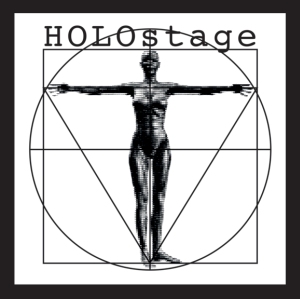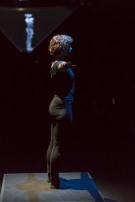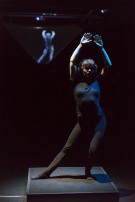be your own AVATAR
 HOLOstage is an extension to the idea of the European Tele-Plateaus project (ETP) by the Trans-Media-Akademie Hellerau (TMA). The actual background of the HOLOstage project is the 3D representation of the dancers who not only transmit position data and the silhouette of the virtual performers but in this special case their entire joint coordinate data, either with the help of motion capture in the camera interface or camera systems which PrimeSense depth sensors enable a three-dimensional mapping. In this virtual resolution with real-time transmission the coordinates of the entire body allow to decrypt the dancers as 3D characters.
HOLOstage is an extension to the idea of the European Tele-Plateaus project (ETP) by the Trans-Media-Akademie Hellerau (TMA). The actual background of the HOLOstage project is the 3D representation of the dancers who not only transmit position data and the silhouette of the virtual performers but in this special case their entire joint coordinate data, either with the help of motion capture in the camera interface or camera systems which PrimeSense depth sensors enable a three-dimensional mapping. In this virtual resolution with real-time transmission the coordinates of the entire body allow to decrypt the dancers as 3D characters. In the implementation of the aesthetics, it is a wireframe model, which is representative then presented to the presence of the dancers and makes present in a new form. In the model representation this wireframe includes the abstraction of a virtual appearance.
To really stand out as three-dimensional interaction objects for the real dancers available the 3D objects or virtual avatars, which are proxy objects for the performers on the holographic stage, of course need an extension in the visualization then.
Implementation of this new form of three-dimensional presence is the 360° holographic projection, an interactive Cheoptics system with real-time transmission.
For the final performance situation we intend that the real-dancer interacts with three or four avatars and makes contact via image and sound modulation.
When improvising with these otherplace performers and exploring interactive constellations she mediates the simulated presence of virtual dancers directly, so the own creative dance movements happen reactively in a new way.
What is an interaction in a virtual environment when it can give no extended self-experience for the protagonist and no extended immersive experience will arise for the spectators? HOLOstage is a production of the Trans-Media-Akademie Hellerau, which is funded in a METABODY project development and already in the first stage shows partnerships.
Gallery
HOLOstage at CYNETART 2014; photos by David Pinzer










































































HOLOstage team / Trans-Media-Labor Hellerau
Jo Siamon Salich (concept, project direction, production design) Frieder Weiß (software development) Matthias Härtig (programming) Johanna Roggan (dance performer) Katharina Groß (documentation) Thomas Dumke (project coordination)
HOLOstage-Phase I / CYNETART 2014 intro performance
dance performer Johanna Roggan
sound costumes by DAP Lab London Michèle Danjoux (design, art direction)
Johannes Birringer (choreography)
HOLOstage is a production of the Trans-Media-Akademie Hellerau
in the frame of the european cooperation initiative Metabody – Media Embodiment Tékhne and Bridges of Diversity
partner: HELLERAU – Europäisches Zentrum der Künste Dresden,
DAP-Lab – Brunel Universität West London,
pms professional media service Dresden
Supported by the European Commission via the Programme CULTURE, the city council Dresden as well as the Cultural Foundation of Saxony.
Jörg Sonntag
September 2014
Performances @ CYNETART 2014
THU 13th of November, 9.30 pm
FRI 14th of November, 8.30 pm
SAT 15th of November, 8.30 pm
Video of a performance
Dancer: Johanna Roggan.
Installation
HOLOstage - Stage 1 - could be seen as installation during the CYNETART exhibition times 2014 at Festspielhaus Hellerau.
http://www.cynetart.de/eholostage2014
Theoretical and philosophical background of the HOLOstage development.
In addition to the three-dimensional avatar projection in three-dimensional space the philosophical approach of the holographic world-view or better said the holographic model of our reality interested me in the project's development. This model, which in its scientific nature also vividly conveys an imagination and intuition resonates a certain fascination which one can hardly escape and is perfectly compatible with the fascination of a spatially-virtual avatar projection.
Background of the holographic model or the afterimage of our reality is quantum physics. The model was first developed by physicist David Bohm who operated with Albert Einstein at Princeton University. Bohm began to do research in the fields of quantum mechanics and relativity theory. Along with Karl Pribram - a neuroscientist at the University of Stanford - he developed the holographic model of reality.
Pribram's studies were dedicated to how memories are stored in the brain. His holographic theory states that the brain stores information in the same manner in which information is stored in a hologram. One of the reasons why both approaches found each other was that the same mathematical calculation - called Fourier transformation - which is used for the computation of holograms also is used in the human brain to process information about sensations (see, hear, touch). The fusion of both approaches eventually gave rise to the holographic model of our reality.
The hologram which can develop its three-dimensionality by a multiple reflected laser beam forming the image information has the characteristic, when dissecting the 3D afterimage, each individual part of the dissected hologram, in turn, may generate the entire 3D image again. The only thing that is lost in this case is the resolution respectively the image sharpness that decreases when partial fragments get smaller.
An insight that has been derived from the holographic model of reality is that you better should imagine our reality as an image instead of a solid construction. The reality we see perhaps corresponds more like a three-dimensional projection, similiar a shadow of a two-dimensional projection of a three-dimensional body. One of the unexplained phenomena of quantum physics of David Bohm is the seemingly direct communication without any time delay between two physical particles that are located at a great distance from each other. According to the theory of relativity nothing can travel faster in space than the speed of light. But experiments show that the information is exchanged between two particles without delay.
To explain the three-dimensional reference setting Bohm developed the analogy of the so-called aquarium model. In this pilot project he positioned two video cameras from different perspectives in front of an aquarium in which a goldfish floated. It sends the recording of the two cameras on two monitors, which are located in another room and it was shown to a subject who did not know the experiment. The statement of the visitor who sits in front of monitors will always be a match for the most obvious association. He sees two fish in two different aquariums. When the fish began to move on the screen it seemed as if the two fish communicated with each other to coordinate their movements. Only when the experimental setup is explained to the observer it became clear that both monitors show the same fish.
The theory of David Bohm states that the three-dimensional reality in which we live is only the projection of a deeper reality. At the level of this deeper reality a communication can take place immediately and without delays, because on this deeper level all particles are connected to each other because they are all part of the same hologram. Bohm thinks that any separation that we feel in our reality is based on a false idea and that we are not aware about the togetherness at the lower level. The holographic model of reality could also explain paranormal phenomena such as telepathy or telekinesis. If it would be possible that a person on an intellectual level consciously accesses the deeper levels of reality, the person could not only get access to the thoughts of other people, but also could move an object by manipulating the model of the object at the lower level before it is projected in our reality.
This model had very much influence on my project development.
In order to realize a three-dimensional real-time transmission the perspectives of the cameras in the aquarium-experimental design and the necessary technical send and receive arrangement led me to transmit the holographic 3D image of the avatar from the four basic perspectives in the hologram. On the other hand it is the mapping method from which the avatar established its virtual reality.
Since our creation process of a projected avatar in the holographic pyramid is based on a particle-distribution that generates a wireframe object, our experimental arrangement is close to a virtual-digital particle process.
The fact that the emitter which is responsible for the particle distribution has attraction parameters, makes it possible to let the holographic avatar to be only shown in times of the presence of a performer in the system. The performer must also meet conditions in the system to obtain the physicality of his avatar. This project is a plea to slow down.
Only in the concentrated slowness of their own body movements the communication with the avatar is stable. While the performer being too dynamic the avatar will be destroyed and adds itself back to a body-afterimage when an unexcited position has been found and this restful position can be endured.
The tremendous acceleration of the processes in our society certainly lead to the fact that we are no longer able to recognize the deeper levels of our communication and coordination skills and to live them. We are still assuming that an extended immersion can take place through the multiplication of our sensations. I claim the opposite.
I3, the Virtual Reality Triangle is composed of the polarities: immersion, imagination and interaction. Utilising these three assignments it describes how intense we can "plunge" into a virtual environment and, by definition the transition into a state of consciousness in which the perception of oneself in the real world decreases and the identification with the self (the avatar) in the virtual world increases. But in our model test of an interaction with a holographic afterimage the avatar also influences the state of consciousness of the person in the real world.
Jo Siamon Salich
September 2014
documentary video of stage 1
